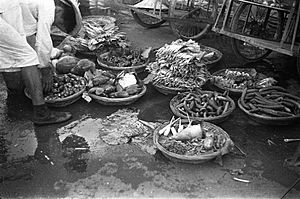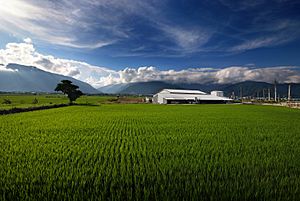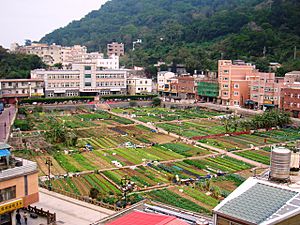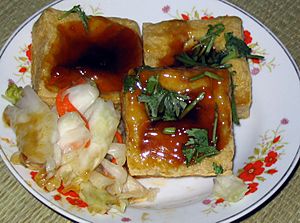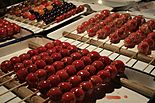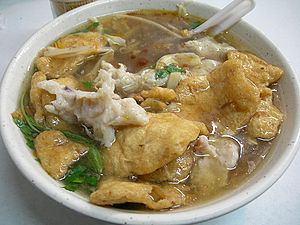Taiwanese cuisine facts for kids
Taiwanese cuisine (Chinese: 臺灣料理; pinyin: Táiwān liàolǐ; Pe̍h-ōe-jī: Tâi-oân liāu-lí, Bopomofo:ㄊㄞˊㄨㄢˉㄌㄧㄠˋㄌㄧˇ, or Chinese: 臺灣菜; pinyin: Táiwāncài; Pe̍h-ōe-jī: Tâi-oân-chhài, Bopomofo:ㄊㄞˊㄨㄢˉㄘㄞˋ) has many different styles. The first foods of Taiwan came from the Taiwanese indigenous peoples. Over hundreds of years, Taiwanese food has been shaped by Hakka cuisine, the foods of people who moved to Taiwan from mainland China (called waishengren), and Japanese cuisine. However, food from southern Fujian cuisine in China has had the biggest impact.
Contents
- How Taiwanese Food Developed
- Ingredients and Food Culture
- Regional Food Specialties
- Popular Taiwanese Dishes
- Delicious Desserts
- Night Market Foods
- Food of the Taiwanese Indigenous Peoples
- Drinks in Taiwan
- Fine Dining in Taiwan
- International Foods in Taiwan
- Taiwanese Food Around the World
- Learning to Cook
- See also
How Taiwanese Food Developed
The story of Taiwanese food is a bit unclear and is closely linked to how people moved to the island and who ruled it. Because Taiwan has a complex and diverse identity, it can be tricky to explain its food history.
Taiwanese cuisine began with the food of the native people who lived on the island long ago. Starting in the Ming dynasty in the 16th century, many people from southern China, especially the Hoklo people, brought their rich Chinese cooking styles to Taiwan. At the same time, Hakka people from Fujian developed their own food culture, different from the Hoklo people. Because of these Chinese influences, Taiwanese food is often seen as 'Southern Chinese cuisine'.
During the time of Japanese rule, Taiwanese food was also greatly influenced by Japanese washoku and yōshoku (Western-style Japanese food). After World War II, many people from mainland China moved to Taiwan with the Kuomintang government. They brought even more Chinese cooking styles from places like Guangdong, Chaoshan, Shanghai, Sichuan, and Beijing. Over the years, these regional dishes changed and became part of Taiwanese cuisine.
Ingredients and Food Culture
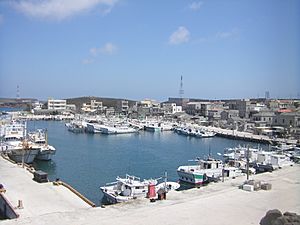
Common ingredients in Taiwan include pork, seafood, chicken, rice, and soy. Traditionally, rice was the main part of most Taiwanese meals. Before the Japanese came, most rice grown in Taiwan was long-grained indica rice. The Japanese introduced short-grained japonica rice, which changed how Taiwanese people farmed and ate. Today, Taiwanese people generally prefer rice that is plump, smells good, is a bit firm, and sweet.
Taiwan's location on a crowded island also shaped its food. People had to find protein sources beyond farms. So, seafood is a big part of their cooking. This includes large fish like tuna and grouper, smaller fish like sardines and anchovies. Crustaceans, squid, and cuttlefish are also eaten. Milkfish is the most popular fish because it's versatile, tender, and affordable.
Beef is less common than other meats. Some older Taiwanese people still avoid eating it. This comes from a traditional respect for cattle used for farm work. However, after many people from mainland China arrived in the 1900s, the Taiwanese version of beef noodle soup became very popular. After WWII, American food aid brought wheat, beef, and processed meats like Spam. This changed the Taiwanese diet, making wheat-based noodles, breads, and dumplings more central.
Taiwan has many different fruits because it's in a sub-tropical area. You can find papayas, starfruit, melons, and citrus fruits. Many kinds of tropical fruits, both local and imported, are enjoyed. Fresh ingredients are easy to find in markets.
Taiwanese cooking uses many seasonings for flavor. These include soy sauce, rice wine, sesame oil, fermented black beans, pickled radish, pickled mustard greens, peanuts, chili peppers, cilantro, and a local type of basil (Chinese: 九層塔; Pe̍h-ōe-jī: káu-chàn-tha̍h; literally "nine-story pagoda").
Taiwanese black vinegar is special. It's made from sticky rice and aged in clay pots. It's used to add flavor to dishes and as a dipping sauce.
An important part of Taiwanese food is xiaochi (小吃). These are like substantial snacks, similar to Spanish tapas. Many travelers visit Taiwan just to try xiaochi. The best place to find them is at a night market. Each night market has its own famous xiaochi.
Xiaochi can also be found in fancy restaurants now. These places use better ingredients and creative ways to serve the dishes. The Taiwanese government supports xiaochi and holds national events for them.
Modern Taiwanese food is also shaped by Taiwan's freedom. This allows chefs to try new things and be creative.
Vegetarian and Vegan Food
Vegetarian restaurants are very common in Taiwan. This is mainly because of Buddhism and other religions like I-Kuan Tao. These restaurants offer many different dishes, from all-you-can-eat buffets to regular menus. Vegetarian places often have a left-facing swastika symbol.
In recent years, more young people in Taiwan are becoming vegetarian or vegan for reasons other than religion. They care about animal welfare, their health, and the environment. Taiwanese companies that traditionally made vegetarian products are now making plant-based meats. Taiwan is a leader in this area, with many companies exporting their products around the world.
Regional Food Specialties
| Region | Dish | Han Characters | Taiwanese Hokkien (Tâi-lô) | Description | Photo |
|---|---|---|---|---|---|
| Changhua | ba-wan | 肉圓 | bah-ôan | These are large dumplings made from a soft tapioca starch dough. They are filled with pork and vegetables like mushrooms and bamboo shoots. | 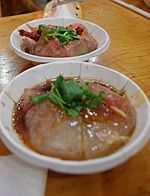 |
| Chiayi | turkey rice | 火雞肉飯 | hoe-koe bah-pn̄g | Bowls of rice topped with shredded turkey. They often come with pickled radish. A special sauce made from turkey drippings and soy sauce is poured over the rice. | 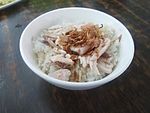 |
| Chiayi/Tainan | Coffin bread | 棺材板 | koann-chhâ-páng | This dish is like French toast or bread bowl soups, but with savory fillings. Thick bread is dipped in egg, deep fried, cut open, and filled with things like black pepper beef or curried chicken. | 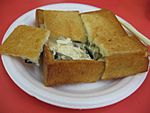 |
| Daxi | Daxi dried tofu | 大溪豆乾 | Tāi-khe tāu-koaⁿ | Firm tofu that is fried and cooked in a sweet soy-based sauce, then dried. | |
| Hsinchu | pork balls | 貢丸 | kòng-ôan | Often eaten in soup (Chinese: 湯; thng). | 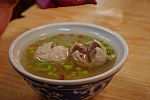 |
| Hsinchu | rice vermicelli | 米粉 | bí-hún | Thin, chewy rice noodles. Often eaten 'dry' (Chinese: 乾; ta/kan, without soup) with mushroom and ground pork. | |
| Nantou | yi mein | 意麵 | ì-mī | Soft, tender noodles served in soup. | |
| Taichung | suncake | 太陽餅 | One of Taichung's most famous pastries. It is a baked, layered pastry with a sweet center, often made with honey or molasses. | 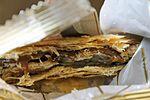 |
|
| Tainan | milkfish congee | 虱目魚肚粥 | A breakfast dish that is a type of rice porridge with milkfish belly. | 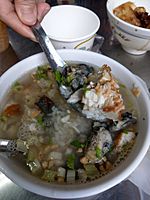 |
|
| Tainan | ta-a mi | 擔仔麵 | tàⁿ-á-mī | Also known as slack season noodles. These are yellow "oily noodles" served with minced pork, shrimp, bean sprouts, cilantro, black vinegar, garlic, soy sauce, and egg. | 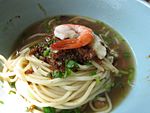 |
| Tamsui | a-gei | 阿給 | a-geh | Deep-fried tofu stuffed with crystal noodles, sealed with fish paste, and topped with spicy sauce. | 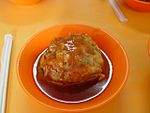 |
| Tamsui | Tamsui fish ball | 魚丸 | hî-ôan | Tamsui is by the ocean, so it's a good place to try their fish balls. These are balls of fish paste filled with meat and garlic, cooked in a light broth. | |
| Tamsui | iron eggs | 鐵蛋 | thih-nn̄g | Eggs that have been cooked many times in spices and air-dried. They become dark brown, chewy, and very flavorful. | 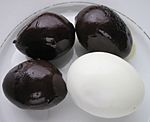 |
Popular Taiwanese Dishes
| Common English term | Han Characters | Taiwanese Hokkien (Tâi-lô) | Mandarin Pinyin | Influence | Description | Photo | |
|---|---|---|---|---|---|---|---|
| Gua bao | 刈包 | koah-pau | guàbāo | Fujian | A flat, steamed white bun shaped like a clam. It's filled with pork belly cooked in soy sauce, pickled mustard greens, peanut powder, sugar, and cilantro. | 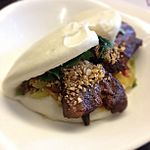 |
|
| Cuttlefish geng | 魷魚羹 | jiû-hî keⁿ | yóuyúgēng | Local | A clear, thick soup with cuttlefish covered in fish paste. | 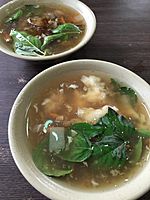 |
|
| Oyster omelette | 蚵仔煎 | ô-á-chian | ézǐjiān | Fujian | A chewy omelette made with eggs, oysters, tapioca starch, and Garland chrysanthemum leaves. It has a soft, sticky texture and is eaten with a sweet and slightly spicy sauce, topped with cilantro. This is a very popular snack at night markets. |  |
|
| Oyster vermicelli | 蚵仔麵線 | ô-á mī-sòaⁿ | ézǐ miànxiàn | Local | A thickened soup with small oysters and steamed misua (Chinese vermicelli noodles). | 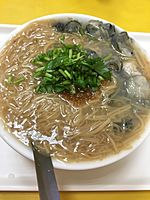 |
|
| Bubble tea | 珍珠奶茶 | zhēnzhū nǎichá | Local | The original milk tea uses black tea, milk, and sugar. The pearls or boba are chewy tapioca pearls. It's a very popular drink, invented in Taichung. | 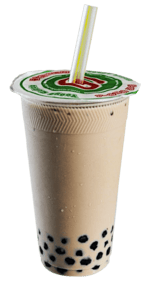 |
||
| Pig's blood cake | 豬血糕 / 豬血粿 |
ti-huih-ko / ti-hoeh-kóe |
zhūxiěgāo/ zhūxiěguǒ |
Fujian | A cake made from pork blood and rice. It's usually served on a stick, dipped in soy sauce, with hot sauce if you like, and topped with peanut powder and cilantro. | 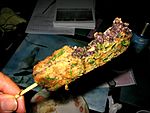 |
|
| Lo bah png (Minced pork rice) | 滷肉飯/魯肉飯 | ló͘-bah-pn̄g | lǔròufàn | Fujian | Minced or ground fatty pork, cooked in soy sauce and spices, served over rice. | 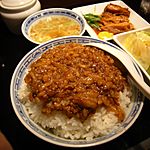 |
|
| Khong bah png (Braised pork rice) | 炕肉飯/爌肉飯 | khòng-bah-pn̄g | kàngròufàn | Fujian | Pork chunks, cooked in soy sauce and spices, served over rice. | 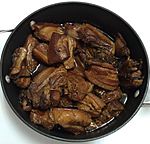 |
|
| Small sausage in large sausage | 大腸包小腸 | tōa-tn̂g pau sió-tn̂g | dàcháng bāo xiǎocháng | Local | A grilled Taiwanese pork sausage wrapped inside a grilled, sticky rice sausage. Often served with garlic and basil. You can choose different flavors like black pepper or chili. A common night market snack. |  |
|
| Sanbeiji | 三杯雞 | sam-poe-koe | sānbēijī | Jiangxi | A chicken dish that means "three cups chicken." It's named because the sauce is made with one cup of rice wine, one cup of sesame oil, and one cup of soy sauce. | 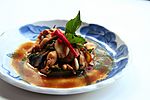 |
|
| Dried radish omelet | 菜脯蛋 | chhài-pó͘-nn̄g | càifǔdàn | Local | Finely cut Taiwanese-style preserved white radish cooked into an omelet. | 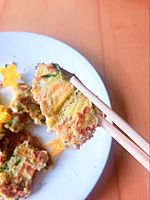 |
|
| olen | 黑輪 | o-lien' | Hēi lún | Japan | This dish uses fish cake, cooked in a pot with fish soup and other ingredients. It's similar to Oden. | ||
| Cucumber pork | 瓜子肉 | koe-á bah | guāzǐròu | Guangdong | Steamed, minced pork with Taiwanese-style pickled cucumber. | ||
| Spicy hotpot | 麻辣鍋 | ba-luah e | málàguō | Sichuan | This hotpot is very popular, especially in Taipei. The soup is very spicy and includes Chinese herbs. People cook their own ingredients in the soup. | ||
| Eel noodles | 鱔魚意麵 | siān-hî ì-mī | shànyú yìmiàn | Local | Rice eel with Yi mein noodles in a thick, sweet and sour soup. | 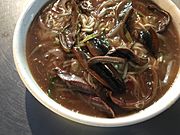 |
|
| Danbing | 蛋餅 | nn̄g-piánn | Dàn bǐng | Local | A breakfast dish made from a thin dough of flour, potato starch, and glutinous rice flour. An omelet is cooked on top. | 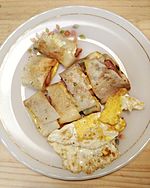 |
|
| Chhau-a-koe | 草仔粿 | chháu-á-kóe / chháu-á-ké | cǎozaǐguǒ | Fujian | A type of kuih (cake) made with glutinous rice flour, sugar, and a paste from Jersey cudweed or Chinese mugwort. It's often filled with dried shrimp, shiitake mushrooms, white radish, and deep-fried shallots. | 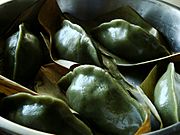 |
|
| Moon shrimp cake | 月亮蝦餅 | ge̍h-liāng hê-piánn | yuèliàng xiābǐng | Thai/Southeast Asia | Common in Taiwanese Thai restaurants. Shrimp, garlic, and pork fat are mashed, spread on a round spring roll wrapper, covered with another wrapper, then pan-fried. Served with sweet chili sauce. |  |
|
| Taiwanese Beef Noodle Soup | 臺灣牛肉麵 | dái-wán gu-bà mi | táiwān niúròumiàn | Local | A red-braised version of beef noodle soup. | 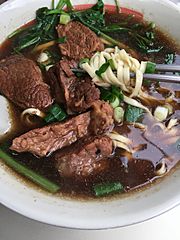 |
|
| Tube rice pudding | 筒仔米糕 | tâng-á-bí-ko | Tǒng zǐ mǐ gāo | Local | A dish of stir-fried glutinous rice that is seasoned and steamed in a bamboo tube. | 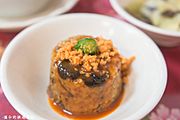 |
There's a type of outdoor barbecue called khòng-iô. To do this, you first build a hollow pyramid with dirt clods. Then, you burn charcoal or wood inside until the pyramid is very hot. Food like taro, yam, or chicken is placed in cans, and the cans are put inside the pyramid. Finally, the pyramid is knocked over the food until it's cooked.
Many non-dessert dishes are seen as snacks, not main meals. They are similar to Cantonese dim sum or Spanish tapas. These dishes are usually lightly salted, with many vegetables accompanying the meat or seafood.
Delicious Desserts
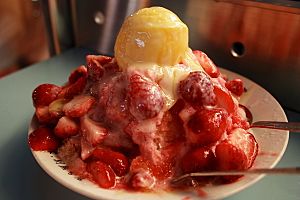
- Aiyu jelly – A jiggly dessert made from the seeds of a creeping fig. It's served on ice.
- O'ahping (Chinese: 芋仔冰; Pe̍h-ōe-jī: ō͘-á-peng) – An ice cream made from taro root paste.
- Tshuah-ping (also called Baobing) – A Taiwanese shaved ice dessert. It's very common in China, Taiwan, Malaysia, and Vietnam.
- Xue-bing (雪花冰) - Also known as "snow ice" or "shaved snow." This is different from tshuah-ping because the ice base is creamy, often flavored (like milk, taro, or chocolate). The shaved snow is very fine and melts quickly. Common toppings include sweetened condensed milk, mangoes, sweetened red beans, boba pearls, or taro.
- Bubble tea, also called boba milk tea or pearl milk tea. It has chewy tapioca balls added to milk tea.
- Traditional cakes can be different depending on the flavor. There is the moon cake, which has a thick filling, usually from lotus seed paste or sweetened red bean paste. It's surrounded by a thin crust and might have salted duck egg yolks. Mooncakes are traditionally eaten during the Mid-Autumn Festival.
- Grass jelly (Chinese: 仙草; Pe̍h-ōe-jī: sian-chháu) – Made from Mesona procumbens. Served hot or cold.
- Moachi (Chinese: 麻糍; Pe̍h-ōe-jī: môa-chî), a soft rice cake similar to Japanese mochi. The fillings can be different kinds of beans or nuts.
- Pineapple cake – A square pastry filled with pineapple. It's one of Taiwan's most famous desserts and a popular souvenir.
- Chhau-a-koe – Cakes made with glutinous rice flour dough mixed with a paste from Gnaphalium affine or Mugwort. This gives it a unique flavor and green color. The dough is often filled with ground meat or sweet bean pastes.
- Douhua (豆花) - Soft tofu served with syrup and toppings like peanuts, adzuki beans, tapioca, and mung beans. Served hot or cold.
- Chocolate - Taiwan grows cocoa in Pingtung in Southern Taiwan. Taiwan is one of the few places that grows cocoa and also makes chocolate.
Night Market Foods
Taiwan's most famous snacks are found in its night markets. Here, street vendors sell many different foods, from finger foods and drinks to sweets and sit-down meals. You can find fried and steamed meat-filled buns, oyster omelets, refreshing fruit ices, and more. Besides food, night markets also have vendors selling clothes, accessories, and offering entertainment.
In 2014, The Guardian newspaper called Taiwan's night markets the "best street food markets in the world."
| Common English term | Han Characters | Taiwanese Hokkien (Tâi-lô) | Mandarin Pinyin | Influence | Description | Photo |
|---|---|---|---|---|---|---|
| Takoyaki | 章魚燒 | Japanese | A ball-shaped snack filled with diced octopus and fried in a flour batter. It can be eaten with sauces like wasabi. Commonly found at night markets. | |||
| Wheel cake | 車輪餅 | chhia-lûn-piáⁿ | chēlúnbǐng | Japanese | Pancake batter is poured into hot molds and quickly cooked into small cakes. They come in many shapes and often have fillings like cream, red bean paste, or peanut butter. Similar to Imagawayaki or Taiyaki. | |
| Stinky tofu | 臭豆腐 | chhàu-tāu-hū | chòudòufǔ | Chinese | Stinky tofu is very popular in Taiwan. It's called "Stinky tofu" because of its strong smell. It was even a favorite food of Empress Dowager Cixi in the Qing dynasty. There are two main kinds: soft stinky tofu and dried stinky tofu. | |
| Taiwanese meatball | 肉圓 | bah-oân | ròuyuán | Local | A sticky, soft tapioca dough filled with pork, bamboo shoots, and shiitake mushrooms. It's served with a savory, sweet, and spicy sauce. | |
| Maize | 玉米 | yùmǐ | American | Vendors might specialize in one type of corn or offer varieties like savory/salty and sweet corn. The corn is steamed, grilled, or boiled. | ||
| Taiwanese sausages | 香腸 | ian-chhiâng (煙腸) | xiāngcháng | Chinese | Fatty pork sausages with a mild sweet taste. There are several kinds. Sometimes Kaoliang wine is used in the recipe. At night markets, they are often served on a stick with different sauces. Sometimes, they are wrapped in glutinous rice. | |
| Green onion pancake | 蔥油餅 | cōngyóubǐng | Chinese | A flour pancake with many thin layers, made with green onions. Cheese and egg are popular extra fillings. This snack came from mainland China. | ||
| Tanghulu | 糖葫蘆 | tánghúlú | Chinese | Red candy-coated, bite-sized fruit served on a stick. Sometimes the fruit is stuffed with preserved plums before being candied. Cherry tomatoes and strawberries are also used. | ||
| Grilled squid | 烤花枝 | kǎo huāzhī | Japanese | Grilled squid, often marinated and brushed with sauce while cooking. | 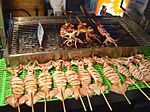 |
|
| Shaved ice | 礤冰/剉冰/刨冰 | chhoah-peng | cuòbīng/bàobīng | Local | Finely shaved ice with many toppings like peanuts, fruit, azuki beans, and sweetened corn. Sometimes drizzled with condensed milk. | |
| Tempura | 甜不辣 | tiánbùlà | Japanese | Deep-fried surimi and fish cakes cooked in broth and served with a sweet sauce. It's similar to Satsuma-age, which is called Tempura in some parts of Japan. It's not related to Japanese Tempura (the fried battered food), but more like Japanese Oden. | ||
| Taiwanese spring roll | 潤餅 | jūn-piáⁿ / lūn-piáⁿ | rùnbǐng | Fujian | The Taiwanese spring roll is a thin, slightly crispy flour crepe filled with various ingredients. These can include powdered sugar, peanut powder, egg, vegetables, pork, and even seafood. | 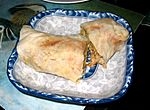 |
| Shawarma | 沙威馬 | shāwēimǎ | West Asian | A sandwich usually made with spiced, grilled chicken. It's served on a soft bun with shredded cabbage, a slice of tomato, sliced onions, ketchup, and mayonnaise. It came from Turkey decades ago, but the seasoning is different from Turkish shawarma. | ||
| Popcorn chicken | 鹹酥雞/鹽酥雞 | kiâm-so͘-ke / kiâm-so͘-koe | xiánsūjī / yánsūjī | American | Popcorn chicken is made from spiced, deep-fried chicken. It's topped with salt and pepper and seasoned with fragrant basil. It's loved for its juicy and tender texture. | 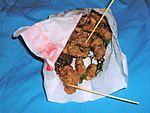 |
| Fried chicken fillet | 炸雞排 | zhá jīpái | American | Fried chicken fillet is one of Taiwan's most popular snacks. It's made from chicken breast that is flattened, marinated, battered, and deep-fried. After cooking, it's sprinkled with ground pepper. It's crispy outside and tender inside. | ||
| Rousong or Pork Floss | 肉鬆 | Ròusōng | Chinese | 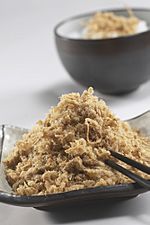 |
- Many drinks are also sold, from bubble tea stands to juice and tea stands.
- Crêpes - Adapted from the original French version, these thin cooked pancakes have a much crispier texture, like a cracker. They were popular in the early 2000s.
- Fruit or bean smoothies - Milk or ice is blended with fresh papaya, mango, watermelon, azuki bean, or mung bean.
- Fried glutinous rice balls - Slightly sweet.
Food of the Taiwanese Indigenous Peoples
Taiwan's food culture is very diverse, with a lot of influence from Han Chinese people. However, the food of the Taiwanese indigenous peoples is still a very important part of it. Even though indigenous people make up less than 2% of Taiwan's population, their foods and cooking methods are very different from the more common Chinese-influenced dishes.
The diet of the indigenous people depended a lot on nature. They were skilled hunter-gatherers, using the plants and wild animals around them. What they ate depended on where they lived – by the coast or in the mountains. Tribes like Amis, Atayal, Saisiyat, and Bunun hunted and gathered what they grew. Tribes like the Yamis and Thao mainly ate fish. Most foods included millet, taro, sweet potato, wild greens, and game like boar and rat. This is different from the Han people, who mainly ate rice and chicken.
For those in the mountains, game meats included deer and flying squirrel intestines, which the Bunun people considered a special treat. Another unique food is 'stinky' meat – game that has started to rot. It's then barbecued, fried, seasoned with garlic and ginger, and served with spicy sauce.
The Amis ate many greens, believing that if a cow could eat it, so could humans. The Bununs, who hunted wild animals, ate stone-grilled pork, boar, deer, and hog roast. The Yami tribe, on the Taitung coast, ate many types of fish, including the special 'flying fish' (Alibangbang). A special dish includes rice mixed with river fish and wild vegetables, served in large bamboo trunks.
Besides being a main food, millet was always used to make wine. Millet wine was not just for drinking; it was also important for offerings during festivals, births, and weddings. Millet wines are made in the homes of the indigenous people.
Sweet potato and taro are also important to indigenous Taiwanese cuisine. They were favored because they grow easily and don't need much care. Root vegetables were grown more than typical seedling plants. Evidence shows this happened as early as 4000 BC.
Because they didn't have modern cooking tools like refrigerators or gas stoves, indigenous people used other ways to prepare food. After hunting, they would preserve meat with millet wine or salt. Another method involved heating stones with fire, then placing them inside a pot with meats and seafood. The food would cook from the heat of the stones. Most foods were steamed, boiled, or roasted to blend flavors while keeping the original taste. Meat was also cooked over a fire on a bamboo stick.
Modern Indigenous Cuisine
Even though Taiwan has many different foods, some restaurants keep the spirit of indigenous cuisine alive. Chefs in these restaurants might change traditional recipes a bit for modern tastes, but they still focus on natural foods. There are competitions that encourage chefs to use traditional indigenous ingredients in healthy and creative ways. These efforts help promote the wonderful taste of indigenous Taiwanese cuisine.
The importance of wild greens to indigenous food is becoming more recognized. Wild greens are both plants found in the forest and those grown in gardens.
Drinks in Taiwan
Taiwanese people drink less alcohol than people in South Korea and Japan. This might be because about half of Taiwan's population has a gene that makes it harder to process alcohol. During the Japanese colonial period, making alcoholic beverages became an industry. In 1922, the government took control of all alcohol production. Modern Taiwanese drinking habits and how drinks are made are still influenced by this time.
Coffee
The first coffee plants in Taiwan were brought by the British to Tainan in 1884. The first small farms grew coffee in New Taipei City's Sanxia District. Tainan is still a major center for coffee culture in Taiwan. Coffee production reached its highest point in 1941 after the Japanese introduced arabica coffee plants. Most coffee sold in Taiwan is imported. In 2020, there were over 15,000 coffee shops in Taiwan. That year, people in Taiwan drank more coffee than tea for the first time.
Tea
Taiwanese tea is considered some of the best in the world, and Taiwan has a unique tea culture.
Whisky
Taiwan has a new but growing whisky industry. This is helped by a huge local market for whisky, especially single malt scotch. Taiwan is the only whisky market where people drink more single malt whisky than blended whisky.
Wine
For a long time, making wine independently was against the law in Taiwan because of a government monopoly. Independent winemakers became legal in 2002. In 2014, a Taiwanese wine won its first gold medal at an international competition. In 2019, a red wine from Taichung won a gold medal in France.
Fine Dining in Taiwan
Fine dining in Taiwan often mixes different food styles. For example, wedding parties in Taiwan usually start with Japanese sashimi, followed by traditional Taiwanese and Chinese dishes.
The Michelin Guide started reviewing restaurants in Taipei in 2018 and Taichung in 2020. In 2020, 30 restaurants in Taiwan received Michelin stars. The Cantonese restaurant Le Palais has three stars, making it the highest-rated restaurant in the country. The 2020 list also gave the Bib Gourmand award to 54 restaurants in Taipei and 21 in Taichung.
There are big differences between fine dining in Taipei and Taichung. In Taichung, there's a focus on grand events with large tables and private rooms. Restaurants often have many parking spaces. In Taipei, fine dining restaurants are generally smaller, with most customers being couples or small groups. Service is usually less formal. Taipei's fine dining scene has more international influence, while Taichung keeps a strong connection to traditional dishes.
International Foods in Taiwan
Fusion Cuisine
Fusion cuisine is very popular in Taiwan. Many Taiwanese dishes are a mix of different cultures. For example, the Taiwanese version of pastel de nata (a Portuguese egg tart) is a result of Portuguese influence from nearby Macao.
Italian Food
Italian cuisine has been popular in Taiwan for a long time. However, until the late 1990s and early 2000s, there were few authentic Italian restaurants or Italian chefs. After the financial crisis of 2007–08, many Italians moved from Italy to countries with stronger economies. This led to a quick increase in Italian restaurants and Italian people living in Taiwan. While most restaurants follow traditional Italian meal styles, the portion sizes are influenced by Italian-American cuisine. Taiwanese diners have become very interested in and knowledgeable about Italian food.
Pizza
Pizza is one of the most popular foods in Taiwan. The first pizza restaurant opened in the 1970s. The industry grew quickly in the 2000s because younger, wealthier people who had traveled abroad wanted good Italian and American style pizza.
Chain pizza restaurants like Pizza Hut and Domino's Pizza are known for making unusual pizzas with toppings like spicy hotpot, cilantro and century egg with pig’s blood, beef and kiwi, glutinous rice, ramen, and stinky tofu. They do this to get attention both in Taiwan and around the world. Pizza Hut came to Taiwan in 1986, and Domino's followed in the late 1980s. In 2022, each company had over 150 stores in Taiwan.
Indian Food
Indian food became popular in Taiwan in the 2000s. The number of Indian restaurants has grown as more Indian and South Asian people have moved to Taiwan. However, most customers in Indian restaurants are local Taiwanese. Indian food can also be found in university cafeterias and other places.
Japanese Food
Taipei, in particular, is known for having some of the best Japanese food outside of Japan. This is because of the history of Japanese rule and the ongoing cultural and business connections between the two places.
Taiwanese Food Around the World
Taiwanese food is found all over the world. Taiwanese chefs have been very successful abroad, cooking both Taiwanese and international dishes. A well-known chef is André Chiang.
In the United States
Taiwanese immigrant restaurant owners played a big part in changing American Chinese food. It went from being mostly Cantonese-focused to including dishes from many regions in China. Taiwanese chefs started moving to the United States in the 1950s. At that time, cooks in Taiwan were trained in traditional Chinese regional cooking. Taiwanese restaurant owners changed the food scene in many American cities, including New York City. They were pioneers in things like picture menus and food delivery.
Traditionally, Taiwanese food abroad was hard to tell apart from Chinese and Japanese food. This was because many Taiwanese chefs cooked simpler or Western versions of traditional Taiwanese, Japanese, or Chinese dishes. In 2018, there was a fast growth in the number of real Taiwanese restaurants in New York City and across the US. This happened as more people became interested in regional Chinese food and in Taiwan itself. Some people don't like it when Taiwanese food is grouped under regional Chinese food, saying it's not accurate.
Taiwanese American cuisine is now becoming its own unique food style. Myers + Chang in Boston was one of the first restaurants to clearly describe their food this way. In 2018, award-winning chef Stephanie Izard opened a Taiwanese snack/dessert shop in Chicago. Taiwanese food has a strong presence in the San Francisco Bay Area.
Learning to Cook
In the past, cooking education was informal. Apprentices learned from a master chef for many years before cooking on their own. The first college-level cooking course started in 1986 at Danshui Technical College.
Cooking Schools
- Danshui Technical College
- National Kaohsiung University of Hospitality and Tourism
See also
 In Spanish: Gastronomía de Taiwán para niños
In Spanish: Gastronomía de Taiwán para niños


